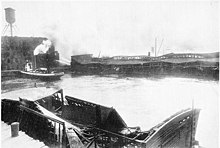| Alternative names | 9 DeKalb Avenue, 340 Flatbush Avenue Extension |
|---|---|
| General information | |
| Status | Completed |
| Type | Mixed-use |
| Architectural style | Neo Art Deco |
| Location | 9 DeKalb Avenue |
| Coordinates | 40°41′26″N 73°58′56″W |
| Construction started | 2018 (residential tower) 1906 (bank) |
| Topped-out | October 28, 2021 |
| Estimated completion | 2022 (residential tower) December 19, 1908 (bank) |
| Height | |
| Roof | 1,073 feet (327 m)[1][a] |
| Technical details | |
| Floor count | 93 |
| Floor area | 555,734 sq ft (51,600 m2) |
| Design and construction | |
| Architect(s) | SHoP Architects (residential tower) Mowbray and Uffinger (original structure) |
| Developer | JDS Development |
| Engineer | Jaros, Baum & Bolles (MEP on Tower) |
| Structural engineer | WSP Global (Tower) |
| Main contractor | JDS Construction |
| Website | |
| jdsdevelopment | |
| Designated | July 19, 1994 |
| Reference no. | 1907 |
| Designated entity | Bank facade |
| Designated | July 19, 1994 |
| Reference no. | 1908 |
| Designated entity | Bank interior |
The Brooklyn Tower (originally referred to as 340 Flatbush Avenue Extension and as 9 DeKalb Avenue) is a supertall mixed-use, primarily residential skyscraper in the Downtown Brooklyn neighborhood of New York City. Developed by JDS Development Group, it is situated on the north side of DeKalb Avenue near Flatbush Avenue. The main portion of the skyscraper is a 93-story, 1,073-foot (327 m) residential structure designed by SHoP Architects. Preserved at the skyscraper's base is the Dime Savings Bank Building, designed by Mowbray and Uffinger, which dates to the 1900s.
The tower is the first supertall building in Brooklyn, as well as the tallest building in Brooklyn and the tallest in New York City outside Manhattan. The Dime Savings Bank Building contains a white-marble facade with colonnades; a diagonal entrance portico on Albee Square; and a domed roof. The bank's interior contains a hexagonal rotunda, which is used as retail space. The building includes 120,000 square feet (11,000 m2) of amenity spaces, some of which are within the bank. The tower section accommodates approximately 150 condominiums and 425 rental apartments, totaling roughly 466,000 square feet (43,300 m2).
The bank building was built in 1906–1908 for the Dime Savings Bank of Brooklyn. The original building, which operated as Dime Savings Bank's main branch for over a century, was expanded by Halsey, McCormack and Helmer in 1931–1932. The bank was sold off in 2014, and the Brooklyn Tower was constructed as an annex to the Dime Savings Bank starting in 2018. The tower's superstructure topped out during October 2021, and sales of the condominiums began in 2022.
https://en.wikipedia.org/wiki/The_Brooklyn_Tower
A rendering of the skyscraper in Downtown Brooklyn
https://en.wikipedia.org/wiki/The_Brooklyn_Tower
1912 postcard
https://en.wikipedia.org/wiki/The_Brooklyn_Tower
https://en.wikipedia.org/wiki/Bath_Iron_Works
Aphrodite in 1899
https://en.wikipedia.org/wiki/Bath_Iron_Works
Aphrodite completed for Oliver Hazard Payne 1899, the largest American built steam yacht at the time
https://en.wikipedia.org/wiki/Bath_Iron_Works

| |
| History | |
|---|---|
| Name | Diamond Shoal Lightship No. 71 (LV-71) |
| Builder | Bath Iron Works |
| Launched | 1897 |
| Homeport | Hatteras, North Carolina |
| Fate | Sunk, 6 August 1918 |
| General characteristics | |
| Type | lightship |
| Complement | 12 officers and men |
Light Vessel 71 (shipwreck) | |
| Nearest city | Buxton, North Carolina |
| NRHP reference No. | 15000541 |
| Added to NRHP | August 19, 2015 |
Diamond Shoal Lightship No. 71 (LV-71) was a lightship of the United States Lighthouse Service. She is most remembered for her sinking in 1918 during World War I when a German U-boat attacked her off North Carolina.[1][2] Her shipwrecked remains were listed on the National Register of Historic Places in 2015.[citation needed]
https://en.wikipedia.org/wiki/United_States_lightship_Diamond_Shoal_(LV-71)









No comments:
Post a Comment